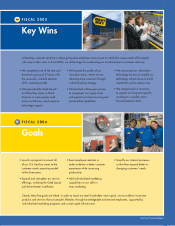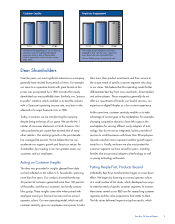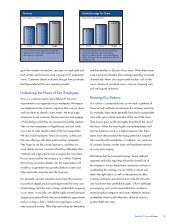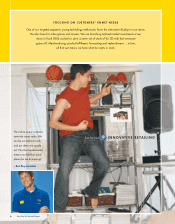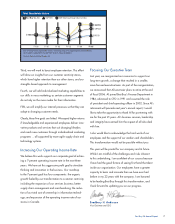Best Buy 2005 Annual Report Download - page 5
Download and view the complete annual report
Please find page 5 of the 2005 Best Buy annual report below. You can navigate through the pages in the report by either clicking on the pages listed below, or by using the keyword search tool below to find specific information within the annual report.
Best Buy 05 Annual Report 1
Dear Shareholders
Over the years, our most significant advances as a company
generally have resulted from periods of stress. For example,
our move to a superstore format with great brands at fair
prices was precipitated by a 1981 tornado that nearly
demolished our most profitable store. Similarly, our “process
to profits” initiative, which enabled us to lead the industry
with a 5-percent operating income rate, was born in the
aftermath of a major financial crisis in 1996.
Today, in contrast, we are transforming the company
despite being at the top of our game. We are the No.1
retailer of consumer electronics in North America. Our
sales productivity per square foot exceeds that of many
other retailers. Our earnings growth in the past decade
has averaged 36 percent. Yet we believe that we can
accelerate our organic growth and boost our returns for
shareholders by investing in our two greatest assets, our
customers and our employees.
Acting on Customer Insights
The idea was grounded in insights gleaned from data
we had collected on 60 million U.S. households, spanning
more than five years. Our analysis showed that the top
20 percent of customers generated more than 100 percent
of the profits, and that our customers are hardly a mono-
lithic group. These insights come alive when paired with
employee training in financial acumen and an owner/
operator culture. Our new operating model, which we call
customer centricity, gives our employees more power to tailor
their store, their product assortments and their service to
the unique needs of specific customer segments who shop
in our stores. We believe that this operating model further
differentiates Best Buy from mass merchants, direct retailers
and online players. These competitors generally do not
offer our assortments of brands, our level of services, our
expertise on digital lifestyles or a fun in-store experience.
At the same time, customer centricity enables us to take
advantage of current gaps in the marketplace. For example,
changing competitive dynamics have left a gap in the
marketplace for serving affluent, early adopters of tech-
nology. Nor do we see an integrated, holistic provider of
services to small businesses with fewer than 20 employees.
Upscale suburban moms represent another growth oppor-
tunity for us. Finally, we know we also must protect the
customer segments we have served for years, including
families that are practical adopters of technology as well
as young technology enthusiasts.
Putting People First, Products Second
Admittedly, Best Buy’s transformation began as a top-down
effort. We began by fostering an owner/operator culture
at a small number of lab stores, which developed new ways
to meet the needs of specific customer segments. In essence,
these stores served as our R&D arm for researching customer
segments and the value propositions that matter to them.
The lab stores delivered impressive top-line results, which
FY 05FY 04FY 03
Employee Engagement
One simple reason employees were more
engaged in their work last year is they knew
more about what was expected of them.
Source: Gallup survey, using 5-point scale
4.1
4.0
3.8
FY 05FY 04FY 03
Customer Loyalty
We believe that expanding our service offerings
can boost customer loyalty (percentage of
customers rating us 5 on a 5-point scale)
which is measured in online customer surveys
every week.
36%36%
34%



